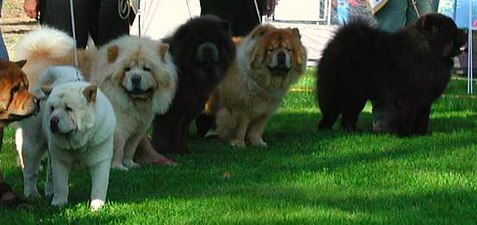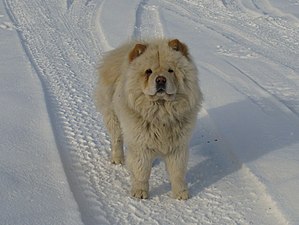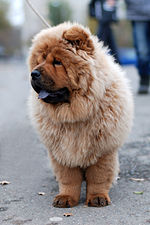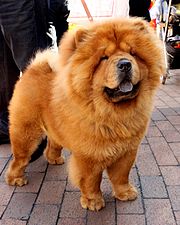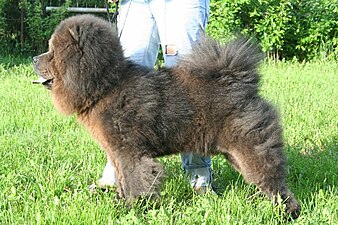Chow Chow
| Chow Chow | |||||||||||||||||||||||||||
|---|---|---|---|---|---|---|---|---|---|---|---|---|---|---|---|---|---|---|---|---|---|---|---|---|---|---|---|
 Chow Chow | |||||||||||||||||||||||||||
| Other names | Chow | ||||||||||||||||||||||||||
| Origin | China | ||||||||||||||||||||||||||
| |||||||||||||||||||||||||||
| |||||||||||||||||||||||||||
| Dog (domestic dog) | |||||||||||||||||||||||||||
The Chow Chow is a spitz-type of dog breed originally from Northern China.[2] The Chow Chow is a sturdily built dog, square in profile, with a broad skull and small, triangular, erect ears with rounded tips. The breed is known for a very dense double coat that is either smooth or rough.[1]: 4–5 The fur is particularly thick in the neck area, giving it a distinctive ruff or mane appearance. The coat may be shaded/self-red, black, blue, cinnamon/fawn, or cream.[1]: 4–5 [3]
History
[edit]
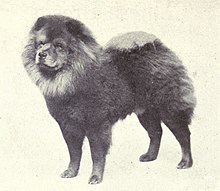
The Chow Chow has been identified as a basal breed that predates the emergence of the modern breeds in the 19th century.[4] A research study has concluded that the Chow Chow dog breed originated from other indigenous dogs in central China about 8,300 years ago. The ancient breed evolved and manifests both morphological and physiological features, including its dark tongue, coat of fur, and stronger build.[5]
One Chinese legend mentions large war dogs from Central Asia that resembled black-tongued lions. One Chinese ruler was said to own 5,000 Chows. The Chinese also used Chows to pull dog sleds through swampy terrain, and this was remarked upon by Marco Polo.[1]: 11
Today, the American Kennel Club registers approximately 10,000 Chow Chows a year. The Canadian Kennel Club registers approximately 350.[1]: 4–5
The English name Chow Chow is unlinked to any Chinese name such as the modern 鬆獅狗 (song shi gou, lit. "loose lion dog") for the breed, and hence of uncertain origin - possible and folk etymologies refer to Pidgin English.[6]
Appearance
[edit]
The Chow Chow is a sturdily built dog, square in profile, with a broad skull and small, triangular, erect ears with rounded tips. The breed is known for a very dense double coat that is either smooth or rough.[1]: 4–5 The fur is particularly thick in the neck area, giving it a distinctive ruff or mane appearance. The coat may be shaded/self-red, black, blue, cinnamon/fawn, or cream.[1]: 4–5 [3] Not all these color varieties are recognized as valid in all countries. Individuals with patchy or multicolored coats are considered to be outside the breed standard. Chow Chow eyes are typically deep set and almond shaped. The breed is unique by their purple/blue-black tongue which no other breed has except Shar Pei, and has very straight hind legs, resulting in a rather stilted gait.[1]: 4–5 The bluish color extends to the Chow Chow's lips; this is the only dog breed with this distinctive bluish color in its lips and oral cavity (other dogs have black or a piebald pattern skin in their mouths).[1]: 4–5 Another distinctive feature is the curly tail.[1]: 4–5 It has thick hair and lies curled on its back. The nose should be black, but blue-coated Chow Chow can have a solid blue or slate-colored nose. According to the American Kennel Club breed standards, any other tone is not acceptable for contests.[7] FCI countries, however, do allow a self-colored nose in the cream.[8]
The blue-black/purple tongue gene appears to be dominant, as most mixed breed dogs that come from a Chow Chow retain that tongue color. However, the blue-black/purple tongue can also be found on the Shar Pei. This is not to say that every mixed breed dog with spots of purple on the tongue is descended from Chow Chow, as purple spots on the tongue can be found on other purebred dogs.[9]
Temperament
[edit]Owning a Chow Chow can raise the cost of homeowners' insurance because some companies consider them high-risk dogs.[10] In a study in the Journal of the American Veterinary Medical Association, Chow Chow were responsible for 8 out of 238 fatalities related to dog bites from 1979 to 1998.[11]
Colors
[edit]Chow Chows can come in a variety of coat colors. The American Kennel Club (AKC) has classified Chow Chow colors as either standard or non-standard (rare colors). The standard colors for Chow Chows are black, blue, red, cream, and cinnamon. However, colors such as fawn, white, and merle are not considered standard for this breed.[12][13]
Different canine clubs worldwide may acknowledge different coat colors or even use alternative names for the colors mentioned above.[13]
- The different Chow Chow colors
-
5 Chow Chows of different coat colors
-
Cream
-
Fawn
-
Red
-
Blue
-
Black
Health
[edit]A UK study found the life expectancy of the Chow Chow to be 12.1 years, just higher than the 12 year average for crossbreeds and lower than the 12.7 years average for purebreeds.[14]
Skeletal conditions
[edit]A North American study looking at more than a million records of dogs found 6.44% of Chow Chow dogs to have hip dysplasia compared with 3.52% overall. The study also found 4.3% of Chow Chow dogs to have cranial cruciate ligament deficiency compared to 2.52% overall.[15]
Another North American study looking at more than 250,000 elbow scans found the Chow Chow to have the highest prevalence of elbow dysplasia, with 48.6% of dogs over the age of 2 having elbow dysplasia.[16]
Ophthalmological conditions
[edit]A North American study looking at glaucoma in dog breeds found the Chow Chow to have the third highest prevalence with 4.7% of Chow Chow dogs having glaucoma compared to 0.89% overall.[17]
Dermatological conditions
[edit]A study looking at records from a small animal clinic at the University of Montreal found the Chow Chow to be predisposed to alopecia X.[18]
A review of studies in Australia found the Chow Chow to be prediposed to atopic dermatitis with a 7.1 odds ratio.[19]
A US case study found a predisposition to pemphigus foliaceus with an odds ratio of 12.3.[20]
A breed specific mutation causing tyrosinase deficiency which results in leukotrichia exists in the Chow Chow.[21]
Gastrointestinal conditions
[edit]A UK study looking at exocrine pancreatic insufficiency in breeds found the Chow Chow to be predisposed to the condition.[22]
Neoplastic conditions
[edit]An Austrian case series found an odds ratio of 23.53 for contracting stomach cancer.[23]
A US study looking at cases of oral melanoma found the breed to be over-represented with an odds ratio of 7.89.[24]
Reproductive conditions
[edit]In a Belgian study Chow Chow bitches made up 6.4% of cases of pyometra despite the breed making up 1.6% of the population. Pyometra was found to be more extreme in the breed with anaemia and endotoxaemia reported.[23]
Other conditions
[edit]The Chow Chow can suffer from diabetes mellitus,[25] and gastric cancer.[26] Chow Chows are a high risk breed for autoimmune disease.[27]
-
A Chow Chow with reddish coat
-
The Chow Chow's fur is particularly thick in the neck area, giving it a distinctive ruff or mane appearance.
Notable dogs
[edit]
Sigmund Freud had a Chow Chow named Jo-Fi Ling who attended all of his therapy sessions because he felt that dogs had a special sense that allows them to judge a person's character accurately, and admitted he depended on Jo-Fi for an assessment of a patient's mental state.[28]
U.S. Navy admiral George Dewey acquired a Chow Chow in Hong Kong in 1898 and named it Bob. Bob rarely left the admiral's side and had the run of the cruiser USS Olympia. Bob died in 1899 from eating chocolates given to Dewey by well-wishers upon Olympia's arrival in New York City.[citation needed]
Walt Disney and his wife, Lillian Disney, had a Chow Chow named Sunnee. It was the couple's first dog. Allegedly, Walt gifted Lilly the Chow Chow inside a hat box, which inspired the scene in Lady and the Tramp where Lady is gifted in the same way.[29][better source needed]
See also
[edit]- Dogs portal
- List of dog breeds
- Eurasier, a dog-breed created through crossing Chow Chow, Wolfspitz and Samoyed dog
- Tibetan Mastiff
References
[edit]- ^ a b c d e f g h i j k l Wilcox, Charlotte (April 1, 1999). The Chow Chow. Capstone. ISBN 978-0-7368-0159-1.
- ^ Case, Linda P. (2005). The Dog: Its Behavior, Nutrition, and Health (2nd ed.), p. 23. Blackwell Publishing. ISBN 0-8138-1254-2.
- ^ a b "Colours and coat types". Chow Chow Club. Archived from the original on March 28, 2012. Retrieved December 16, 2012.
- ^ Larson, G (2012). "Rethinking dog domestication by integrating genetics, archeology, and biogeography". Proc. Natl. Acad. Sci. U.S.A. 109 (23): 8878–83. Bibcode:2012PNAS..109.8878L. doi:10.1073/pnas.1203005109. PMC 3384140. PMID 22615366.
- ^ Hechuan Yang; Guodong Wang; Meng Weng; Yaping Ma; Tingting Yin; Ruoxi Fan; Hong Wu; Li Zhong; David M. Irwin; Weiwei Zhai; Yaping Zhang (2001–2010). "The origin of chow chows in the light of the East Asian breeds". BMC Genomics. 18 (1): 174. doi:10.1186/s12864-017-3525-9. PMC 5312535. PMID 28201986.
- ^ "Chow". Online Etymology Dictionary. Retrieved July 16, 2024.
- ^ American Kennel Club (January 1, 2006). "AKC MEET THE BREEDS: Chow Chow". American Kennel Club. American Kennel Club (AKC). Retrieved July 10, 2012.
- ^ CHOWCHOW.at (June 9, 1999). "The FCI Breed Standard". CHOWCHOW.at. CHOWCHOW.at Alle Rechte vorbehalten. Archived from the original on August 11, 2012. Retrieved July 10, 2012.
- ^ Kathy Welsh; Anna Wallace; Vicki DeGruy (2001–2010). "The Truth About Those Black Tongues". Chow Chow Information and Adoption Center. WisconsinChow Chow Rescue. Archived from the original on September 7, 2019. Retrieved July 10, 2012.
- ^ InsuranceAgents.com. "Will Your Canine Affect Your Homeowners Insurance Policy?". InsuranceAgents.com. AgentInsider.com. Archived from the original on October 14, 2012. Retrieved July 10, 2012.
- ^ J. Sacks, Jeffrey; Sinclair, Leslie; Gilchrist, Julie (September 15, 2000). "Vet Med Today: Special Report – "Breeds of dogs involved in fatal human attacks in the United States between 1979 and 1998"" (PDF). JAVMA. 217 (6): 836–40. doi:10.2460/javma.2000.217.836. PMID 10997153. S2CID 10817039. Archived from the original (PDF) on April 11, 2015.
- ^ "Chow Chow Dog Breed Information". American Kennel Club. Retrieved June 8, 2023.
- ^ a b Jones, Christina (June 18, 2021). "Chow Chow Colors: A Guide To Rare Colors Of Chow Chow Dogs". PupVine. Retrieved June 8, 2023.
- ^ McMillan, Kirsten M.; Bielby, Jon; Williams, Carys L.; Upjohn, Melissa M.; Casey, Rachel A.; Christley, Robert M. (February 1, 2024). "Longevity of companion dog breeds: those at risk from early death". Scientific Reports. 14 (1). Springer Science and Business Media LLC: 531. Bibcode:2024NatSR..14..531M. doi:10.1038/s41598-023-50458-w. ISSN 2045-2322. PMC 10834484. PMID 38302530.
- ^ Witsberger, Tige H.; Villamil, J. Armando; Schultz, Loren G.; Hahn, Allen W.; Cook, James L. (June 15, 2008). "Prevalence of and risk factors for hip dysplasia and cranial cruciate ligament deficiency in dogs". Journal of the American Veterinary Medical Association. 232 (12). American Veterinary Medical Association (AVMA): 1818–1824. doi:10.2460/javma.232.12.1818. ISSN 0003-1488. PMID 18598150.
- ^ Oberbauer, A. M.; Keller, G. G.; Famula, T. R. (February 24, 2017). "Long-term genetic selection reduced prevalence of hip and elbow dysplasia in 60 dog breeds". PLOS ONE. 12 (2). Public Library of Science (PLoS): e0172918. Bibcode:2017PLoSO..1272918O. doi:10.1371/journal.pone.0172918. ISSN 1932-6203. PMID 28234985.
- ^ Gelatt, Kirk N.; MacKay, Edward O. (2004). "Prevalence of the breed-related glaucomas in pure-bred dogs in North America". Veterinary Ophthalmology. 7 (2): 97–111. doi:10.1111/j.1463-5224.2004.04006.x. ISSN 1463-5216.
- ^ DW, Scott; M, Paradis (1990). "A survey of canine and feline skin disorders seen in a university practice: Small Animal Clinic, University of Montréal, Saint-Hyacinthe, Québec (1987-1988)". The Canadian Veterinary Journal. 31 (12): 830–835. ISSN 0008-5286. PMC 1480900. PMID 17423707.
- ^ Mazrier, Hamutal; Vogelnest, Linda J.; Thomson, Peter C.; Taylor, Rosanne M.; Williamson, Peter (May 18, 2016). "Canine atopic dermatitis: breed risk in Australia and evidence for a susceptible clade". Veterinary Dermatology. 27 (3). Wiley: 167. doi:10.1111/vde.12317. ISSN 0959-4493. PMID 27188769.
- ^ Kuhl, K. A.; Shofer, F. S.; Goldschmidt, M. H. (1994). "Comparative Histopathology of Pemphigus Foliaceus and Superficial Folliculitis in the Dog". Veterinary Pathology. 31 (1). SAGE Publications: 19–27. doi:10.1177/030098589403100103. ISSN 0300-9858. PMID 8140722.
- ^ Englar, Ryane E. (July 3, 2019). "Changes in coat color". Common Clinical Presentations in Dogs and Cats. Wiley. p. 140. doi:10.1002/9781119414612. ISBN 978-1-119-41458-2.
- ^ Batchelor, Daniel J.; Noble, Peter-John M.; Cripps, Peter J.; Taylor, Rebecca H.; McLean, Lynn; Leibl, Marion A.; German, AIexander J. (2007). "Breed Associations for Canine Exocrine Pancreatic Insufficiency". Journal of Veterinary Internal Medicine. 21 (2). Wiley: 207–214. doi:10.1111/j.1939-1676.2007.tb02950.x. ISSN 0891-6640.
- ^ a b Gough, Alex; Thomas, Alison; O'Neill, Dan (April 23, 2018). Breed Predispositions to Disease in Dogs and Cats. Hoboken: John Wiley & Sons. pp. 71–72. ISBN 978-1-119-22554-6.
- ^ Ramos-Vara, J. A.; Beissenherz, M. E.; Miller, M. A.; Johnson, G. C.; Pace, L. W.; Fard, A.; Kottler, S. J. (2000). "Retrospective Study of 338 Canine Oral Melanomas with Clinical, Histologic, and Immunohistochemical Review of 129 Cases". Veterinary Pathology. 37 (6). SAGE Publications: 597–608. doi:10.1354/vp.37-6-597. ISSN 0300-9858. PMID 11105949.
- ^ "Diabetes Mellitus". Archived from the original on October 2, 2011. Retrieved July 2, 2011.
- ^ "Positional Cloning of the Gene(s) for Gastric Cancer in the Chow Chow". Archived from the original on October 2, 2011. Retrieved July 2, 2011.
- ^ "Establishment of a Genetic Database for Disease Association Studies in the Major Histocompatibility complex for Purebred Dogs". Archived from the original on October 2, 2011. Retrieved July 2, 2011.
- ^ Coren, Stanley (1997). What Do Dogs Know?. Free Press. p. 128.
- ^ "Walt Disney's Chow "SUNNEE" Inspires Movie". ChowTales. February 4, 2014. Archived from the original on January 16, 2016.

